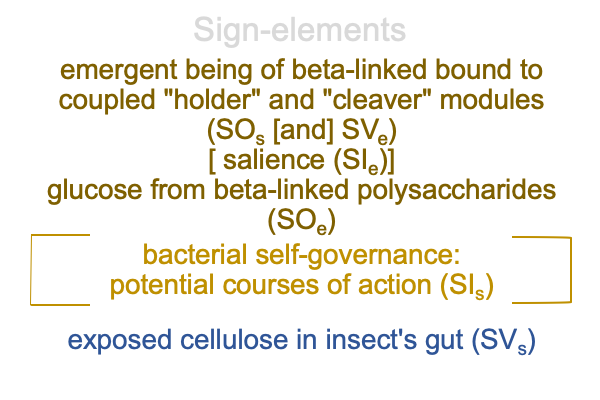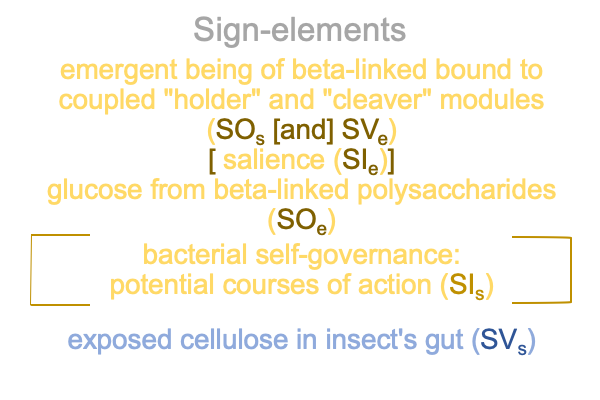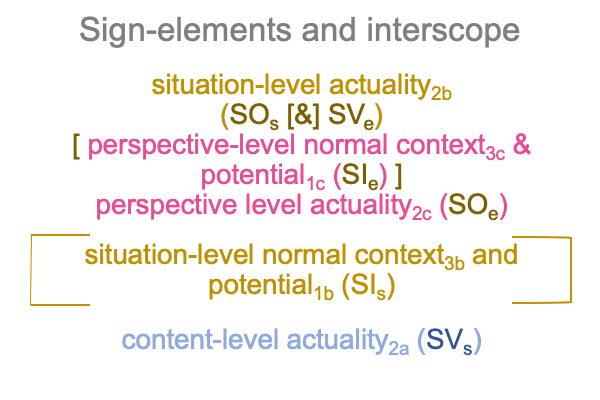0355 The sign-elements associated to the S&T noumenal overlay conveys the new message.

For the specifying sign, exposed cellulose in the wood-eating insect’s gut2a (SVs) stands for the emergent being of a conformationally-distorted beta-linked polysaccharide held in the jaws of a cleaving enzyme2b (SOs) in regards to bacterial self-governance3b operating on potential courses of action1b (SIs).
For the exemplar sign, the emergent being of a beta-linked polysaccharide bound to “the claws and jaws” of new complex2b (SVe) stands for a seemingly endless source of glucose from ingested cellulose2c (SOe) in regards to what certain bacteria in the insect’s gut3c are capable of doing1c (SIe).
0356 Each of the sign-vehicles and the sign-objects have observable and measurable facets that will eventually go into scientific models. The scientific models will assist in accounting for each of the sign-interpretants.
Biosemiotic research may be conducted after phase one is complete.
Biosemiotic research can never tell whether phase one is proceeding.
This is the way of empedoclement.
0357 It seems that the wood-chewing insect, so empowered, would go berserk and start to eat every living plant.
Like ripples in still water, biosemiotic waves propagate.
If these wood-chewing insects go after a living plant, then all that plant needs to do is develop a toxin that poisons those little beta-linkage breaking bacteria. Problem solved.
Okay, so these new insects are not invulnerable?
0358 Tell that to the exterminator.
The exterminator facing a wood-eating insect infiltration, knows that certain principles apply. He assesses signs. Is communication (section 10.3) an issue here? I suppose that depends on who is doing the talking and who is receiving the message.
0359 Peirce’s definition of a sign as a triadic relation is crucial for biosemiotics. So, are Peirce’s three categories. Even before getting to a question of communication, there is a character to the S&T overlay that embodies the relational structure of specifying and exemplar sign-relations.
Here is a picture.

0360 These sign-elements, in turn, represent locations in a three-level interscope. An interscope is a category-based nested form composed of category-based nested forms. Each nested form exhibits a normal context3, actuality2 and potential1. Then, the nested forms compose the three levels of contenta, situationb and perspectivec.
See A Primer on the Category-Based Nested Form and A Primer on Sensible and Social Construction, by Razie Mah, available at smashwords and other e-book venues.
0361 I will not show a picture of the three-level interscope.
Instead, here is how the elements of the three-level interscope correspond to elements in the S&T noumenal overlay.

0362 For the specifying sign-relation, a content-level actuality2a (SVs) stands for a situation-level actuality2b (SOs) in regards to a situation-level normal context3b and potential1b (SIs).
For the exemplar sign-relation, the situation-level actuality2b (SVe) stands for a perspective-level actuality2c (SOe) in regards to a perspective-level normal context3c and potential1c (SIe).
0363 In terms of communication, I can imagine that the SVs is like a transmission sent and the SOe is like the transmission received.
